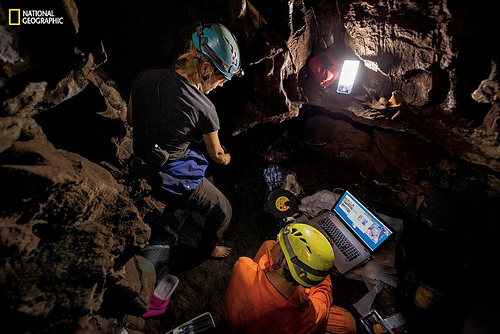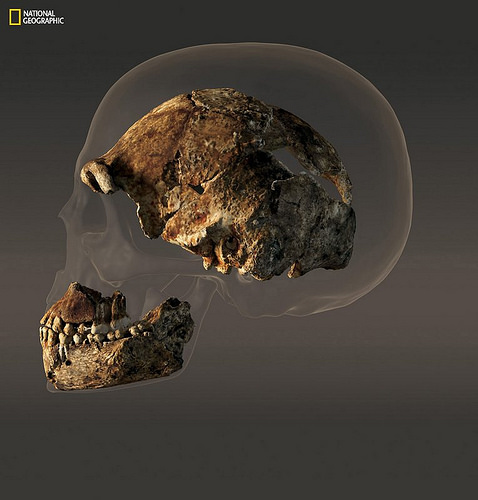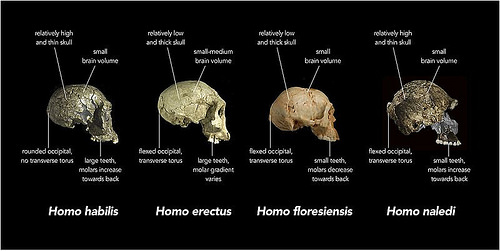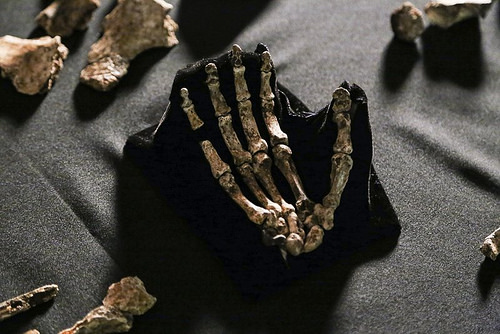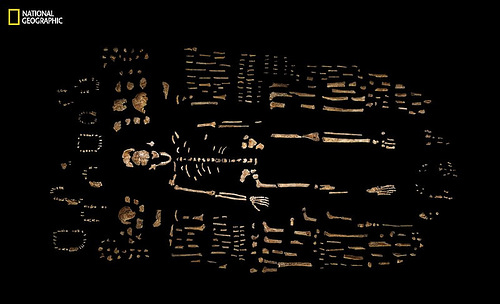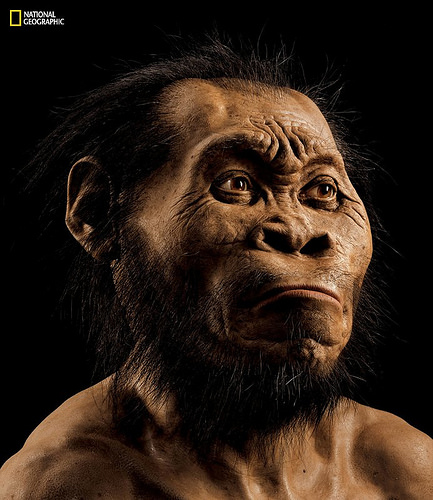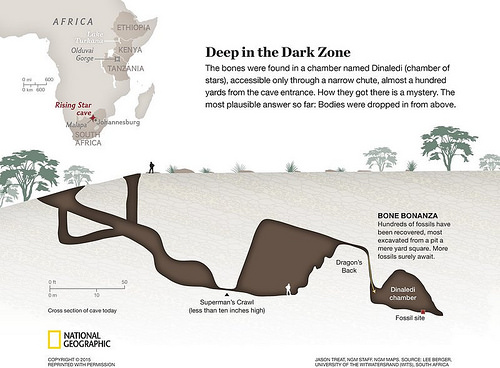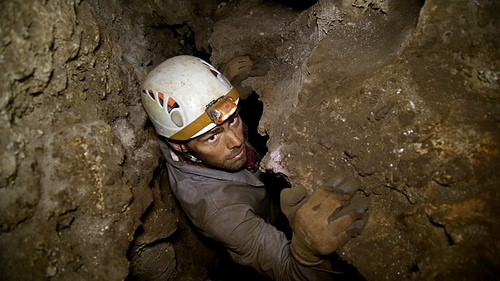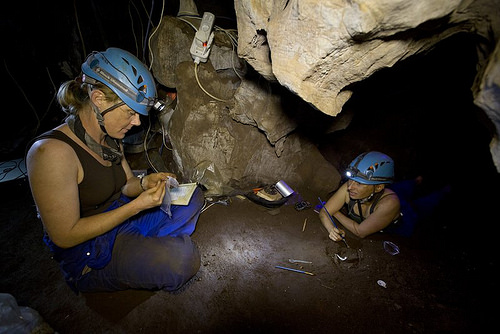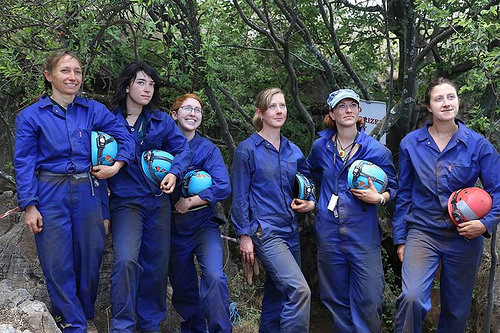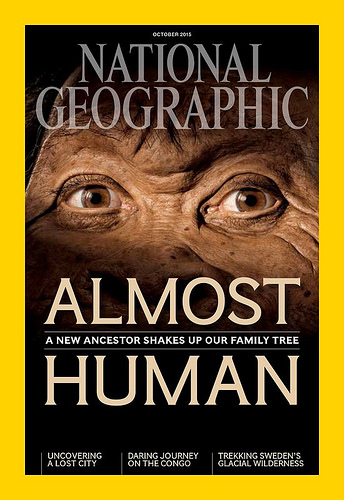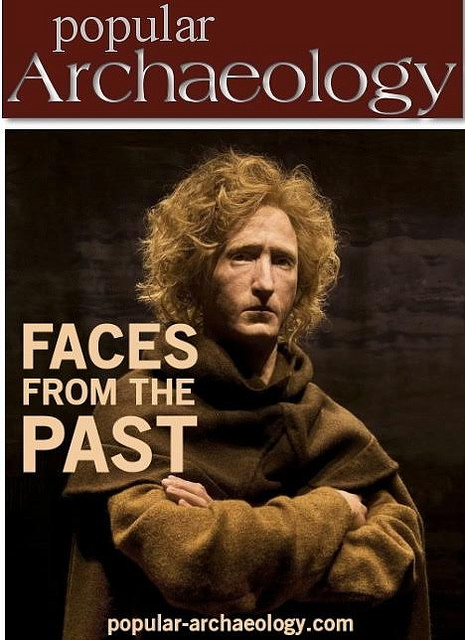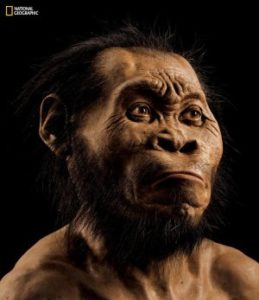 A reconstruction of Homo naledi’s head by paleoartist John Gurche, who spent some 700 hours recreating the head from bone scans. The find was announced by the University of the Witwatersrand, the National Geographic Society and the South African National Research Foundation and published in the journal eLife. Photo by Mark Thiessen/National GeographicPERMITTED USE: These images may be downloaded or are otherwise provided at no charge for one-time use for media/news coverage or promotion of the National Geographic Society’s H. naledi announcement and exclusively in conjunction thereof. Copying, distribution, archiving, sublicensing sale, or resale of the images are prohibited.DEFAULT: Failure to comply with the prohibitions and requirements set forth above will obligate the individual or entity receiving these images to pay a fee determined by the National Geographic Society.Mandatory usage requirements for National Geographic magazine photos 1-10:Please note:A maximum of 5 images total may be used onlineA maximum of 5 images total may be used on airA maximum of 3 images total may be used in print
ONLINE: 1. Include mandatory photo credit with each image
2. Must show the October cover of National Geographic magazine somewhere in the piece if using two (2) or more images3. Provide a prominent link to http://natgeo.org/naledi4. Mention that the images are from "the October issue of National Geographic magazine”BROADCAST:1. Include mandatory photo credit with each image
2. Show the October cover of National Geographic magazine at some point during the segment
3. Provide a verbal mention of "the October issue of National Geographic magazine”
PRINT:1. Include mandatory photo credit with each image2. Must show the October cover of National Geographic magazine somewhere in the piece if using two (2) or more images3. Mention that the images are from "the October issue of National Geographic magazine”*Contact Carol King Woodward (ckingwoo@n
A reconstruction of Homo naledi’s head by paleoartist John Gurche, who spent some 700 hours recreating the head from bone scans. The find was announced by the University of the Witwatersrand, the National Geographic Society and the South African National Research Foundation and published in the journal eLife. Photo by Mark Thiessen/National GeographicPERMITTED USE: These images may be downloaded or are otherwise provided at no charge for one-time use for media/news coverage or promotion of the National Geographic Society’s H. naledi announcement and exclusively in conjunction thereof. Copying, distribution, archiving, sublicensing sale, or resale of the images are prohibited.DEFAULT: Failure to comply with the prohibitions and requirements set forth above will obligate the individual or entity receiving these images to pay a fee determined by the National Geographic Society.Mandatory usage requirements for National Geographic magazine photos 1-10:Please note:A maximum of 5 images total may be used onlineA maximum of 5 images total may be used on airA maximum of 3 images total may be used in print
ONLINE: 1. Include mandatory photo credit with each image
2. Must show the October cover of National Geographic magazine somewhere in the piece if using two (2) or more images3. Provide a prominent link to http://natgeo.org/naledi4. Mention that the images are from "the October issue of National Geographic magazine”BROADCAST:1. Include mandatory photo credit with each image
2. Show the October cover of National Geographic magazine at some point during the segment
3. Provide a verbal mention of "the October issue of National Geographic magazine”
PRINT:1. Include mandatory photo credit with each image2. Must show the October cover of National Geographic magazine somewhere in the piece if using two (2) or more images3. Mention that the images are from "the October issue of National Geographic magazine”*Contact Carol King Woodward (ckingwoo@n They were having the time of their lives.
In late 2013 and early 2014 they uncovered more than 1,550 bones representing at least 15 ancient individuals from a small, dark, nearly inaccessible chamber in the “Rising Star” cave system in South Africa. Long a caving destination for spelunkers, the Rising Star system is part of a complex of limestone caves near what is called “The Cradle of Humankind,” a World Heritage Site in Gauteng province well known for critical paleoanthropological discoveries of early humans. But at any level, this particular discovery was an extremely rare event. Then, after meticulous analysis of the bones, this international team of scientists knew they had come across something remarkable. So remarkable, in fact, they decided to designate the bones as belonging to an entirely new species of hominin. They called it Homo naledi.
Designated as the “Dinaledi Chamber”, the finds within have gone on record as the largest single assemblage of hominin fossils in any one location in Africa. What’s more, “the combination of anatomical features in H. naledi distinguishes it from any previously known species,” said Lee Berger of the University of the Witwatersrand. Berger led the two expeditions* that discovered and recovered the fossils. “With almost every bone in the body represented multiple times, Homo naledi is already practically the best-known fossil member of our lineage.”
So what were these scientists looking at?
“Overall, Homo naledi looks like one of the most primitive members of our genus, but it also has some surprisingly human-like features, enough to warrant placing it in the genus Homo,” said John Hawks of the University of Wisconsin-Madison, U.S., an expedition participant and a senior author of the research paper describing the new species. “H. naledi had a tiny brain, about the size of an average orange (about 500 cubic centimeters), perched atop a very slender body.” The research shows that on average H. naledi stood approximately 1.5 meters (about 5 feet) tall and weighed about 45 kilograms (almost 100 pounds).
A gracile creature with a brain not much larger than a chimpanzee.
But this was no chimpanzee. This was something else. Something more human.
According to the examining scientists, this creature had teeth and skull features similar to those of the earliest-known members of our genus, such as Homo habilis. Certain key features of the hands suggested “tool-using capabilities”, according to Dr. Tracy Kivell of the University of Kent, U.K., who was part of the team that studied H. naledi’s anatomy. And the feet were even more telling. Other than a few notable characteristics, they were “virtually indistinguishable from those of modern humans,” said Dr William Harcourt-Smith of Lehman College, City University of New York, and the American Museum of Natural History, who led the study of H. naledi’s feet. Its feet, combined with its long legs, he suggested, indicated that the species was well-suited for upright, long-distance walking—just like us. These were all trademark traits attributable to humans.
But there were clearly more “primitive”, ape-like traits, as well. The much smaller brain, for one. The shoulders were much more similar to those of apes, and like apes, the fingers of the hand had “extremely curved fingers, more curved than almost any other species of early hominin, which clearly demonstrates climbing capabilities,” said Kivell—features that facilitated a tree-climbing life. Moreover, this creature exhibited a short, ape-like torso and the pelvis resembled that of an Australopithecine, a more ape-like protohuman relative, fossils of which have now long been a part of the broad range of hominin finds in Africa to date.
________________________________________________
Anthropologist Marina Elliott (left) and paleontologist Ashley Kruger explore a side chamber in the Rising Star cave where more than 1,500 fossil elements of a new species, Homo naledi, were discovered. Elliott was one of six scientists, described as “underground astronauts,” with the skill and physique to reach the remote chamber. National Geographic Explorer-in-Residence Lee Berger of the University of the Witwatersrand (pictured on the computer screen) led the expedition and followed the progress inside the cave from the surface. Photo by Elliot Ross/National Geographic
________________________________________________________________
The braincase of a composite male skull of H. naledi measures just 560 cubic centimeters in volume — less than half that of the modern human skull pictured behind it. The fossils were recovered from the Rising Star cave in South Africa by a team led by National Geographic Explorer-in-Residence Lee Berger of the University of the Witwatersrand. Art: Stefan Fichtel. Sources: Lee Berger and Peter Schmid, Wits; John Hawks, University of Wisconsin-Madison/National Geographic
_____________________________________________________________
Homo naledi skull compared to those of other Homo species. Chris Stringer, Wikimedia Commons
_________________________________________________________________
Skeletal fossils of the hand of Homo naledi pictured in the Wits bone vault at the Evolutionary Studies Institute at the University of the Witwatersrand, Johannesburg, South Africa, on Sept. 13, 2014. The fossil hand is one of many fossils representing a new species of hominin. The broad thumb of Homo naledi suggests it was an expert climber. The Rising Star Expedition, a project that retrieved and analyzed the fossils was led in part by paleoanthropologist John Hawks, professor of anthropology at the University of Wisconsin-Madison. Photo by John Hawks/University of Wisconsin-Madison
_____________________________________________________________
A composite skeleton of H. naledi is surrounded by some of the hundreds of other fossil elements recovered from the Dinaledi Chamber in the Rising Star cave in South Africa. The expedition team was led by National Geographic Explorer-in-Residence Lee Berger of the University of the Witwatersrand. Photo by Robert Clark/National Geographic; Source: Lee Berger, Wits, photographed at Evolutionary Studies Institute
_______________________________________________
A reconstruction of Homo naledi’s head by paleoartist John Gurche, who spent some 700 hours recreating the head from bone scans. Photo by Mark Thiessen/National Geographic
_______________________________________________________________
An ancient depository for the dead?
Perhaps most significantly, study of the context of the finds has led the researchers to conclude that H. naledi may have practiced a form of behavior previously thought to be unique to humans. The fossils, consisting of infants, children, adults and elderly individuals, were found in a deep underground room that has “always been isolated from other chambers and never been open directly to the surface,” said Dr Paul Dirks of James Cook University in Queensland, Australia, lead author of the eLife paper on the context of the find. “What’s important for people to understand is that the remains were found practically alone in this remote chamber in the absence of any other major fossil animals.”
So remote was the space that out of more than 1,550 fossil elements recovered, only about a dozen are not hominin, and these few pieces are isolated mouse and bird remains, meaning that the chamber attracted few accidental visitors. The bones show no marks of scavengers or carnivores or any other signs that non-hominin agents or natural processes, such as moving water, carried these individuals into the chamber. Moreover, there was no evidence that the chamber was ever used as an actual living space by humans, and the age ranges of the skeletons fit the pattern of what archaeologists find in cemeteries. “We explored every alternative scenario, including mass death, an unknown carnivore, water transport from another location, or accidental death in a death trap, among others,” said Berger. “In examining every other option, we were left with intentional body disposal by Homo naledi as the most plausible scenario.” This suggests the possibility of a form of ‘ritualized’ behavior previously thought to be unique to humans (“ritualized” meaning repeated behavior.) “It seems probable that a group of hominins was returning to this place over a period of time and depositing bodies,” Hawks explains, adding that the supposition is akin to discovering similar behavior in chimpanzees. “It would be that surprising.” Furthermore, the way the bodies are arranged and their completeness suggests they were carried to the cave intact. “The bodies were not intentionally covered and we’re not talking about a religious ceremony, but something that was repeated and repeated in the same place. They clearly learned to do this and did it as a group over time. That’s cultural. Only humans and close relatives like Neandertals do anything like this.”
The million dollar question: How old?
Now that scientists have discovered this new hominin species, what about the age?
Dating the finds have been problematic for a number of reasons. First, unlike other fossil deposits in caves, these fossils were found with very few or no fossils of other animals that could be directly associated with the finds, making it impossible to determine a faunal age. Secondly, the few flowstones in the cave that can be directly linked to the fossils are contaminated with clays, making them very difficult to date. Moreover, the fossils are contained in soft sediments that have been partly re-worked and re-deposited by acts of nature over time, making it extremely difficult to establish their primary stratigraphic position.
“We have tried three approaches that have failed to give dates for the actual fossils, and are currently working on further attempts,” report Berger and the scientific team. “Because of the uniqueness of the fossils and the situation in which they are found, we only want to publish age limits for them when we are absolutely sure that they are right.”
Thus the consensus at this point is that it is anybody’s guess. “They could have been there 2 million years ago or 100,000 years ago, possibly coexisting with modern humans,” said Hawks.
One hope, says Hawks, is finding the remains of an animal that may have been a contemporary of Homo naledi. The fossils are embedded in a matrix of soft sediment and there are layers that remain unexcavated.
Nevertheless, given the geographic context with proximity to other already dated caves in the area, such as Sterkfontein, Swartkrans, and Malapa, the scientists suspect that the Dinaledi cave system may fall within the 2-to-3-million-year-old time range, possibly placing H. nadeli near or at the root of the genus Homo, considering the morphology. But at this point, it would be an educated guess.
The Expeditions
The story of this discovery really began with two cavers, Rick Hunter and Steven Tucker, who found the entrance to the Dinaledi Chamber and discovered the fossils. The fossils were thought at the time to be the remains of a single individual. They showed pictures of the fossils to Pedro Boshoff, another caver and geologist. Recognizing the fossils as potentially significant, Boshoff alerted Professor Lee Berger, who then spearheaded the assembly of an expeditionary group (called the “Rising Star Expedition”) of scientists.
On November 10, 2013 the first of these explorers entered the chamber, initiating the first of two expeditionary efforts, the first lasting about 21 days and the second, in early 2014, lasting about one week. The task was not an easy one. Carefully excavating the fossil elements with tools as delicate as toothpicks and brushes, they gently removed the fossils, piece by piece, and transported them up through the narrow 7.5-inch chute, including a second narrow area called the ‘superman’s crawl’ only 10 inches wide, to the surface. More than 60 cavers and scientists worked together in what Marina Elliott, one of the excavating scientists, described as “some of the most difficult and dangerous conditions ever encountered in the search for human origins”. Elliott was one of six women selected as “underground astronauts” from a global pool of candidates after Berger issued a call on social media for experienced scientist/cavers who could fit through the 18-centimeter cave opening. Social media continued to play a role in the project, as the team shared expedition progress with a large public audience, schoolchildren and scientists. “This was a first in the history of the field,” said Hawks, who worked with Berger to design the media outreach.
The fossils were subsequently analyzed in a unique workshop in May 2014 funded by the South African DST/NRF, Wits University and National Geographic. More than 50 experienced scientists and early-career researchers came together to study and analyze the treasure trove of fossils and to compose scientific papers.
____________________________________________
A cross-section showing the Dinaledi chamber within the Rising Star cave near Johannesburg, South Africa, where the fossils of a new species, Homo naledi, were discovered. A team of six “underground astronauts” navigated the extremely narrow chutes to recover more than 1,500 fossil elements discovered in the cave. Jason Treat, National Geographic, Source: Lee Berger, Wits
_______________________________________________
Caver Steven Tucker squeezes through a narrow passage in the Rising Star cave. Tucker was one of the cavers on Lee Berger’s exploration team who found the chamber where H. naledi, a new species of human relative, was discovered. Photo by Garrreth Bird
____________________________________________________________
“Underground astronauts” Marina Elliott and Becca Peixotto work inside the cave where fossils of H. naledi, a new species of human relative, were discovered. Photo by Garrreth Bird
______________________________________________
The “underground astronauts” (left to right): Becca Peixotto, Alia Gurtov, Elen Feuerriegel, Marina Elliott, K. Lindsay (Eaves) Hunter and Hannah Morris. The team of scientists excavated the chamber where H. naledi, a new species of human relative, was discovered. Photo by John Hawks
______________________________________________________________
Going forward
Berger and his team conclude, as they did at the discovery of Australopithecus sediba in 2008, that there are clearly other key transitional forms of hominins that may yet be discovered and added to the fossil record. H. naledi is joining an expanding mosaic of hominin species on an ancient African landscape. The developing picture, in other words, may be becoming enormously complex, with the possibility of a multitude of various hominin species inhabiting the same regions and perhaps even interbreeding, creating what Berger has described as a “braided stream” through time to Home sapiens (modern humans), as opposed to the traditional, linear model advanced by earlier scientists. And as more evidence emerges, more questions are raised.
For now, much remains to be discovered in the Rising Star cave alone. “This chamber has not given up all of its secrets,” Berger said. “There are potentially hundreds if not thousands of remains of H. naledi still down there.”
According to Hawks, years of work remain at the site, including continuing analysis and documentation of all of the materials excavated. Plans, he says, include bringing many new technologies to bear on analyzing the fossils to help determine diet, rate of aging, and where they lived on the landscape.
Readers can find out more in the detailed study reports in eLife.
___________________________________________
*Lee Berger of the Evolutionary Studies Institute, University of the Witwatersrand (Wits University), led the international team of scientists under the joint sponsorship of Wits, the National Geographic Society, and the South African Department of Science and Technology/National Research Foundation,
_________________________________________________________
_________________________________________________________
The discovery is featured as the cover story of National Geographic magazine’s October 2015 issue, available online now and on print newsstands starting September 29, 2015. The NOVA/National Geographic Special, “Dawn of Humanity,” premieres September 16, 2015, at 9 p.m. ET/8 p.m. CT on PBS in the United States and is streaming online now. The program will air outside of the United States later in September. You can follow the conversation using #NalediFossils.
See more videos about this discovery like the one shown in this article at PBS.org at http://www.pbs.org/wgbh/nova/evolution/dawn-of-humanity.html.
The research was supported by Wits University, the National Geographic Society and South African DST/NRF. Ongoing exploration and conservation of the Rising Star site is supported by the Lyda Hill Foundation.
Portions of this article were adapted and edited from sections of subject press releases of the University of the Witwatersrand, New York University, and the University of Wisconsin, Madison.
Cover Image for this article: Photo by Mark Thiessen/National Geographic
_________________________________________________________
In addition, the latest Popular Archaeology ebook is now available.
______________________________________________
Travel and learn with Far Horizons.
____________________________________________
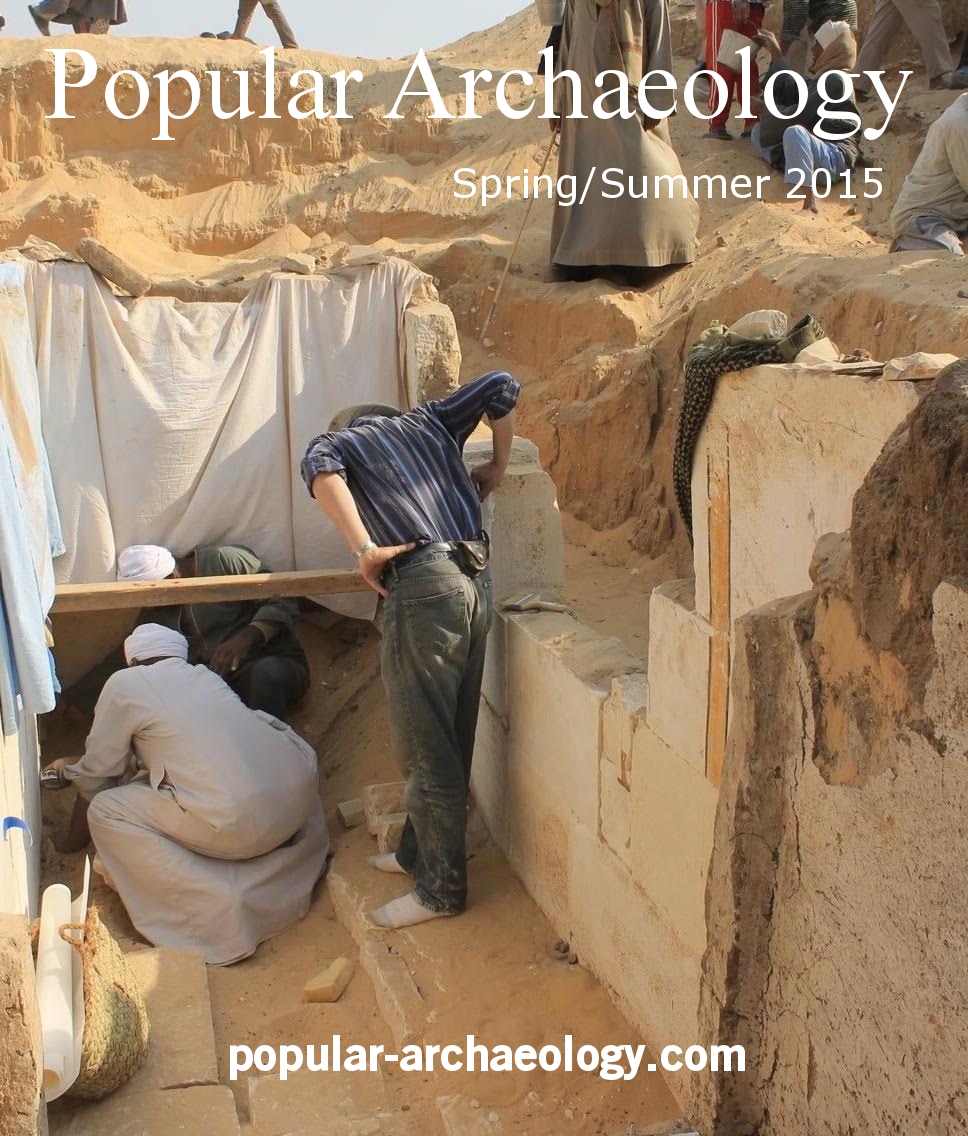 This richly illustrated ebook version of a recent Popular Archaeology issue includes the following stories: The discovery of the tomb of a previously unknown pharaoh that is shedding light on a lost ancient Egyptian dynasty; how genetics is revolutionizing what we know about human evolution and our prehistoric past; one scholar’s controversial ‘New Chronology’ and how it supports the historicity of the biblical Exodus; how archaeologists are unearthing new history in Williamsburg, Virginia, a seat of British colonial power in 18th century America; the discovery of the remains of a major Roman legionary base in Israel; the unearthing of an ancient Judean fortified settlement in the borderlands between the biblical kingdoms of ancient Judah and the Philistines; and how archaeologists are uncovering evidence of what may have been an important administrative center of Judah during the 8th century BCE. Now available from Amazon.com!
This richly illustrated ebook version of a recent Popular Archaeology issue includes the following stories: The discovery of the tomb of a previously unknown pharaoh that is shedding light on a lost ancient Egyptian dynasty; how genetics is revolutionizing what we know about human evolution and our prehistoric past; one scholar’s controversial ‘New Chronology’ and how it supports the historicity of the biblical Exodus; how archaeologists are unearthing new history in Williamsburg, Virginia, a seat of British colonial power in 18th century America; the discovery of the remains of a major Roman legionary base in Israel; the unearthing of an ancient Judean fortified settlement in the borderlands between the biblical kingdoms of ancient Judah and the Philistines; and how archaeologists are uncovering evidence of what may have been an important administrative center of Judah during the 8th century BCE. Now available from Amazon.com!
____________________________________________

